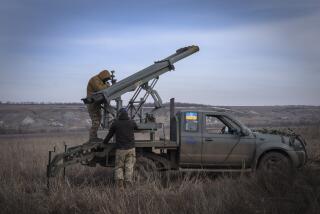Rumsfeld Decides to Kill Artillery System
- Share via
WASHINGTON — Secretary of Defense Donald H. Rumsfeld, confident that he has the clout to overcome congressional opposition, said Wednesday that the Pentagon would kill the $11-billion Crusader artillery system, whether its supporters--who include key Republicans--like it or not.
In announcing his decision to stop development of the 40-ton howitzer, which critics say is emblematic of lumbering Cold War weaponry, Rumsfeld insisted that it represents a critical step in his efforts to streamline and modernize the military.
“What’s going to happen is we are going to do exactly what I said: We’re going to cancel the Crusader; we’re going to make our case persuasively with the Congress,” Rumsfeld told reporters at the Pentagon. “We will persuade as many people as we need, but not all, given the nature of life. And it will end up being canceled.”
But by drawing public battle lines over the fate of the big gun, Rumsfeld has set the stage for a pitched fight on Capitol Hill. The artillery system has been an Army procurement priority--and a potential boon to defense contractors in a number of states.
Already, the House Armed Services Committee has ordered the Pentagon not to cancel the Crusader before the program undergoes a formal review next spring. Republicans on the Senate Armed Services Committee plan to try to do the same.
“It’s very important that Rumsfeld win this, because it will set the precedent on other tough decisions,” said Sen. John McCain (R-Ariz.).
The Crusader announcement marked Rumsfeld’s first cancellation of a major weapon program, although others, including the Marine Corps’ V-22 Osprey hybrid helicopter-airplane, are said to be in jeopardy.
The Crusader is a heavy, self-propelled, rapid-fire cannon that was to have entered service by 2008. The Army argued that it was badly needed to replace the existing Paladin artillery system, which is more than 40 years old and is inferior to heavy artillery used by China, North Korea and others.
Critics say that the Crusader, in development since 1994, is too heavy for the more nimble and mobile forces the administration is seeking to craft in the 21st century.
But the artillery system’s fate has become emblematic of the broader tensions between the military and the Pentagon’s civilian leadership on how the nation’s armed forces should adapt to meet post-Cold War challenges. Army Secretary Thomas E. White, a retired general already under fire for his ties to Enron Corp. and for his use of Pentagon planes while on personal business, drew Rumsfeld’s ire by pushing relentlessly to save the system from the ax.
The unusually public battle between the Army and Rumsfeld’s office had appeared to place White’s job in jeopardy this week.
On Wednesday, White sat near Rumsfeld at a news conference, looking pained, as the Defense secretary made clear that White’s efforts had been in vain.
“The secretary has come to a decision, and the Army will work hard to implement that decision. Full stop. Period,” White said.
The public announcement, and the appearance of White at his side as he made it, appeared to be a move to reassert Rumsfeld’s authority within the Pentagon.
“Rumsfeld being public about the Crusader means the issue has expanded beyond the merits of Crusader itself and really begins to involve the credibility of Rumsfeld and his team,” said Andrew F. Krepinevitch, executive director of the Center for Strategic and Budgetary Assessments, a nonpartisan defense think tank in Washington.
“If they can’t make this decision stick, it will be to some extent because there was this public fight by the Army early on. So ... this decision about the Crusader becomes about not just artillery but about who’s in charge at the Pentagon.”
Rumsfeld’s leadership in the war against terrorism--and his emergence as a Defense secretary so popular that giggling college students jockey to have photos taken with him--has earned him a formidable amount of political capital for his push to cancel the Crusader.
Conflicts loom over how many fighter jets and warships to buy, and over the fate of other weapon systems that are in development.
But despite his public bravado, Rumsfeld faces some formidable foes.
The cannon would be assembled in Elgin, Okla., a state whose congressional delegation includes Rep. J.C. Watts Jr., chairman of the House GOP conference, and Sen. Don Nickles, the assistant Republican leader.
And a White House lobbyist said he assumed that the fight for the Crusader would extend beyond the Oklahoma delegation because parts of the system would be built in dozens of states.
Rumsfeld’s announcement came just as the Senate Armed Services Committee was drafting the year’s defense authorization bill. Two committee members said they expected to debate and vote on the issue today.
Sen. Joseph I. Lieberman (D-Conn.) predicted a “big fight” over the issue but said he was inclined to support the administration. He wanted to “show some respect to the decision the secretary of Defense has made.”
“He has made a tough decision,” Lieberman said. “This is the first gutsy decision made by Rumsfeld.”
But, he added, “it’s difficult to stop any program that’s started.”
He said the timing was terrible--right in the middle of committee debate--but “there are many innings left” in the legislative process.
Asked if defeat on this would make it impossible for Rumsfeld to get any military reform, Lieberman said, “I worry about that.”
Sen. Tim Hutchinson (R-Ark.), a Crusader supporter, predicted that the artillery system would continue to be funded. “I think the votes are going to be there to support the program.”
Rumsfeld was unshaken about the opposition to his plan.
More to Read
Sign up for Essential California
The most important California stories and recommendations in your inbox every morning.
You may occasionally receive promotional content from the Los Angeles Times.











